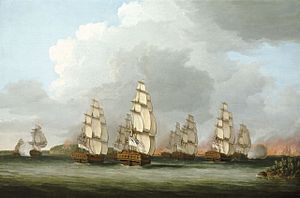Massachusetts ship Tyrannicide (1776) facts for kids
Tyrannicide was a special warship used by the Massachusetts State Navy during the American Revolutionary War. It was a 14-gun sloop-of-war, which means it was a small, fast ship designed for fighting. It was built like a brigantine, a type of sailing ship with two masts. The name Tyrannicide means "tyrant killer," which was a strong message during the war for independence. This ship was very active in attacking British trade ships, a tactic called commerce raiding. Sadly, it was destroyed during a big battle called the Penobscot Expedition.

Artist's depiction of the Royal Navy chasing Tyrannicide up the Penobscot River.
|
|
Quick facts for kids History |
|
|---|---|
| Namesake | "Tyrant killer" |
| Builder | Salisbury, Massachusetts shipyard |
| Launched | July 1776 |
| Homeport | Salem, Massachusetts |
| Fate | scuttled 14 August 1779 |
| General characteristics | |
| Sail plan | brigantine |
| Complement | 75 men |
| Armament | 14 × 6 or 4-pounder guns |
Contents
Early Voyages with Captain John Fisk
The first captain of Tyrannicide was John Fisk, born in Salem in 1744. His First Lieutenant was Jonathan Haraden, and Joseph Stockman was the Second Lieutenant.
Tyrannicide left the shipyard in Salisbury, Massachusetts, on July 8, 1776. Just nine days later, on July 17, it returned to Salem, Massachusetts. During this short trip, the ship captured a British sloop called HMS Dispatch on July 12. This battle lasted 90 minutes. Dispatch had 8 main guns and 12 smaller guns, with a crew of 31 men. Three of their crew, including their commander, were killed, and five were wounded.
In August 1776, Tyrannicide went on another cruise. It sailed between Cape Sable and Nantucket. During this trip, it captured three more ships: the armed ship Glasgow, the brig Saint John, and the schooner Three Brothers. The Tyrannicide almost got caught by a British frigate (a type of warship) that managed to take back one of the captured ships.
Before its next big trip, Tyrannicide was changed from a schooner to a brigantine. This meant changing its sails and masts. On October 29, 1776, the ship sailed to the West Indies. It captured several more ships there: the snow Ann, the brig Henry and Ann, the 140-ton snow John, and the 100-ton brig Three Friends. Tyrannicide returned to Massachusetts on February 14, 1777.
Captain Jonathan Haraden Takes Command
After Captain Fisk, First Lieutenant Jonathan Haraden was promoted to lead Tyrannicide. Captain Fisk then took command of another ship, the brig Massachusetts.
On March 24, 1777, Tyrannicide and Massachusetts sailed together towards Europe. They captured the brig Eagle and the snow Sally, which was carrying English goods from London to Quebec. On April 2, they captured Chalkley, a ship from Honduras heading to Bristol with a cargo of mahogany.
On April 8, Tyrannicide had a three-hour battle and captured the large 500-ton barque Lonsdale. A few weeks later, on April 22, Massachusetts and Tyrannicide worked together to capture a brig that had fallen behind a British convoy.
Tyrannicide captured the 160-ton brig Trepassy on April 30. However, on May 17, it got separated from Massachusetts while being chased by a stronger British group of ships. To escape, Tyrannicide had to throw some of its guns and supplies overboard to make the ship lighter and faster. It managed to escape to Bilbao, Spain, and returned to Boston on August 30, 1777.
On November 21, 1777, Tyrannicide sailed with another ship called Hazard. On December 13, they captured the 130-ton brig Alexander. This ship was from Halifax and was carrying fish, oil, lumber, and barrels to the West Indies. However, a British ship, HMS Yarmouth, took Alexander back on January 22, 1778, near Barbados.
Tyrannicide continued its successful captures. On December 22, it captured the schooner Good Intent and the brig Polly, both from Newfoundland with fish and hoops. Then it captured the snow Swift, which was carrying flour from Bristol. Tyrannicide left the West Indies on March 30, 1778, and returned to Boston in May.
Captain John Allen Hallet's Time
Tyrannicide's next captain was John Allen Hallet, who took command on July 10, 1778. On September 29, 1778, the ship captured a privateer brig called Juno.
After surviving a big storm on March 9, 1779, Tyrannicide captured the 14-gun privateer Revenge on March 31. Revenge had fourteen 4 or 6-pounder guns and two swivel guns, with a crew of 60. Tyrannicide captured two more ships before returning to Boston on April 25, 1779.
Final Voyage with Captain John Cathcart
John Cathcart became the captain of Tyrannicide on May 1, 1779. The ship became part of the Penobscot Expedition, a large naval operation that sailed from Boston on July 24.
During this expedition, the American fleet faced a much stronger British fleet. To avoid being captured, Tyrannicide and other American ships had to retreat up the Penobscot River. On August 14, 1779, near Bangor, Maine, Tyrannicide was burned by its own crew to prevent it from falling into British hands. This was the end of the ship's service in the war.

